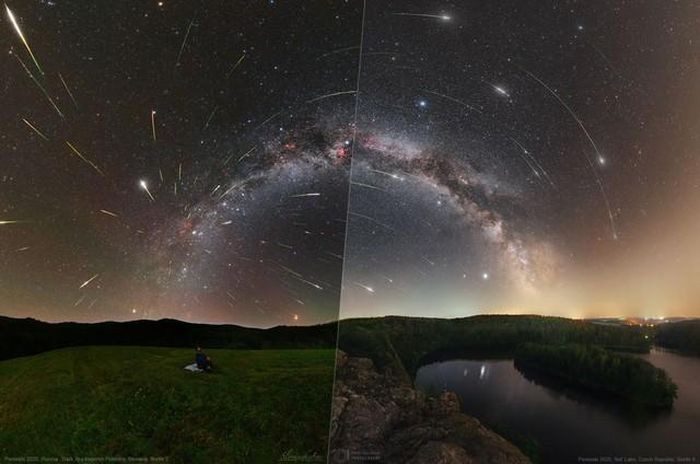The Perseids are the most beautiful meteor shower of the year and the most eagerly awaited astronomical event due to the large number of shooting stars, with hundreds of streaks visible per hour.
When the Meteors Shine Brightest
According to the Hanoi Astronomy Society (HAS), the Perseid meteor shower in August 2023 is a highly anticipated event for astronomy enthusiasts as it is the largest meteor shower of the year. The Perseids, originating from the comet Swift-Tuttle, create stunning displays of shooting stars as Earth passes through icy debris left behind by the comet during its last close approach in 1992.
The peak of the Perseid meteor shower occurs around August 12 and 13 each year. The number of meteors per hour can reach 150-200 streaks in years without moonlight (2016 is an example). On average, you can witness about 100 meteors per hour at the peak of the Perseids.

The Perseid meteor shower in August 2023 is a highly anticipated event for astronomy enthusiasts.
Perseid Meteors
A Perseid meteor (when they are in space) typically travels at a speed of about 200,000 km/h when entering Earth’s atmosphere (known as a meteor). Most Perseid meteors are small and do not leave remnants on the ground; if they do, they are called “meteorites.”
Perseid meteors are fiery objects, reaching temperatures of over 1650 degrees Celsius as they enter Earth’s atmosphere, simultaneously compressing and heating the air in front of them. Most meteors become visible when they are approximately 97 km above the ground.
The Swift-Tuttle Comet
The Swift-Tuttle comet was independently discovered by astronomers Lewis Swift and Horace Tuttle in 1862. Its last visit to Earth was in 1992, but it was quite dim when observed with the naked eye. The next visit in 2126 is expected to shine as brightly as Comet Hale-Bopp did in 1997.
The Swift-Tuttle comet is known as the largest object to cross Earth’s orbit periodically, with a core approximately 26 km wide.
The name Perseids meteor shower is derived from the constellation from which the meteors appear. Observed from Earth, Perseid meteors seem to radiate from the constellation Perseus. You can best observe the Perseid meteor shower in the Northern Hemisphere; all you need is a dark space, a quiet location, and some patience.
Observation Guide
To locate the Perseid meteors, the ideal position is the radiant point from which the meteors appear, known as the “radiant.” According to NASA, the radiant point of the Perseid meteor shower is from the constellation Perseus. Since it can be challenging to find this constellation, you can rely on brighter and more prominent constellations like Cassiopeia. Although the meteor shower is named after the constellation that serves as the radiant, the constellation itself is not their source.
The best way to observe the Perseid meteor shower is to choose a sufficiently dark, quiet, and open space. You do not need any equipment such as telescopes or binoculars; just find the ideal spot and allow your eyes to adjust to the darkness for about 30 minutes.
Observation Timing
This year’s peak will occur on the night of August 12 and the early morning of August 13, 2023, making it an excellent year for observing the Perseid meteor shower since the sky will not be affected by moonlight. You can start observing from the night of the 12th, after the constellation Perseus rises in the Northeast.
In Vietnam, you can witness this beautiful meteor shower in suburban areas, ideally in the mountains, to avoid light pollution, providing a spacious and unobstructed view.
It is recommended to lie down and observe instead of sitting or standing, as this allows you to capture the entire display of the Perseid meteors. Additionally, August is a great time to admire the sparkling Milky Way.
If possible, invite friends or family, prepare snacks, and a cup of hot coffee to make the observation experience as enjoyable as possible. Don’t forget to check the weather beforehand to have the best contingency plans.
Finally, if you love astrophotography, be sure to prepare your photography equipment, such as lenses, cameras, and tripods, and research how to photograph meteor showers to capture the most beautiful moments.


















































